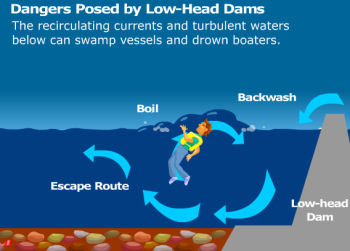Hydraulic Roller: Difference between revisions
No edit summary |
No edit summary |
||
| (5 intermediate revisions by 3 users not shown) | |||
| Line 1: | Line 1: | ||
__NOTOC__ | __NOTOC__ | ||
[[Category:Risk Assessment Public Safety]] | |||
---- | ---- | ||
{{Picture | {{Picture | ||
| Line 8: | Line 9: | ||
<!-- Add picture caption --> | <!-- Add picture caption --> | ||
|caption= | |caption= | ||
Image Source: USACE | |||
}} | }} | ||
<!-- Delete any sections that are not necessary to your topic. Add pictures/sections as needed --> | <!-- Delete any sections that are not necessary to your topic. Add pictures/sections as needed --> | ||
| Line 15: | Line 16: | ||
==Examples== | ==Examples== | ||
{{Website Icon}} | {{Website Icon}} [https://damfailures.org/case-study/dock-street-dam-pennsylvania/ Learn more about the dangers of hydraulic rollers as experienced at Dock Street Dam (DamFailures.org)] | ||
<noautolinks>==Best Practices Resources==</noautolinks> | |||
{{Document Icon}} [[Dam Safety Warning Signs Best Practices (FEMA P-2188) | Dam Safety Warning Signs Best Practices (FEMA P-2188), FEMA]] | |||
==Trainings== | ==Trainings== | ||
{{Video Icon}} [[On-Demand Webinar: Identifying Hazards and Improving Public Safety at Low Head Dams]] | {{Video Icon}} [[On-Demand Webinar: Identifying Hazards and Improving Public Safety at Low Head Dams]] | ||
Latest revision as of 18:11, 19 July 2023

|
| Image Source: USACE |
The hydraulic roller is one of the most common and most lethal hazards of low-head dams. Under certain water conditions, a dangerous submerged hydraulic roller can form immediately downstream of a low-head dam. As the water flow crests and falls to the base of the dam, it creates a recirculating current that pushes anything caught in it to the bottom of the stream, dragging it along the stream bed, then releasing it up to the surface of the water, then sucking it back into the face of the dam. This circulation can keep people, boats, and other objects trapped for an extended amount of time, repeatedly slamming them against the dam wall. These forces are brutal and largely inescapable. The surface of the water can often appear to be calm, hiding the submerged dangers below.
Examples
Best Practices Resources
![]() Dam Safety Warning Signs Best Practices (FEMA P-2188), FEMA
Dam Safety Warning Signs Best Practices (FEMA P-2188), FEMA
Trainings
![]() On-Demand Webinar: Identifying Hazards and Improving Public Safety at Low Head Dams
On-Demand Webinar: Identifying Hazards and Improving Public Safety at Low Head Dams
Citations:
Revision ID: 7331
Revision Date: 07/19/2023
